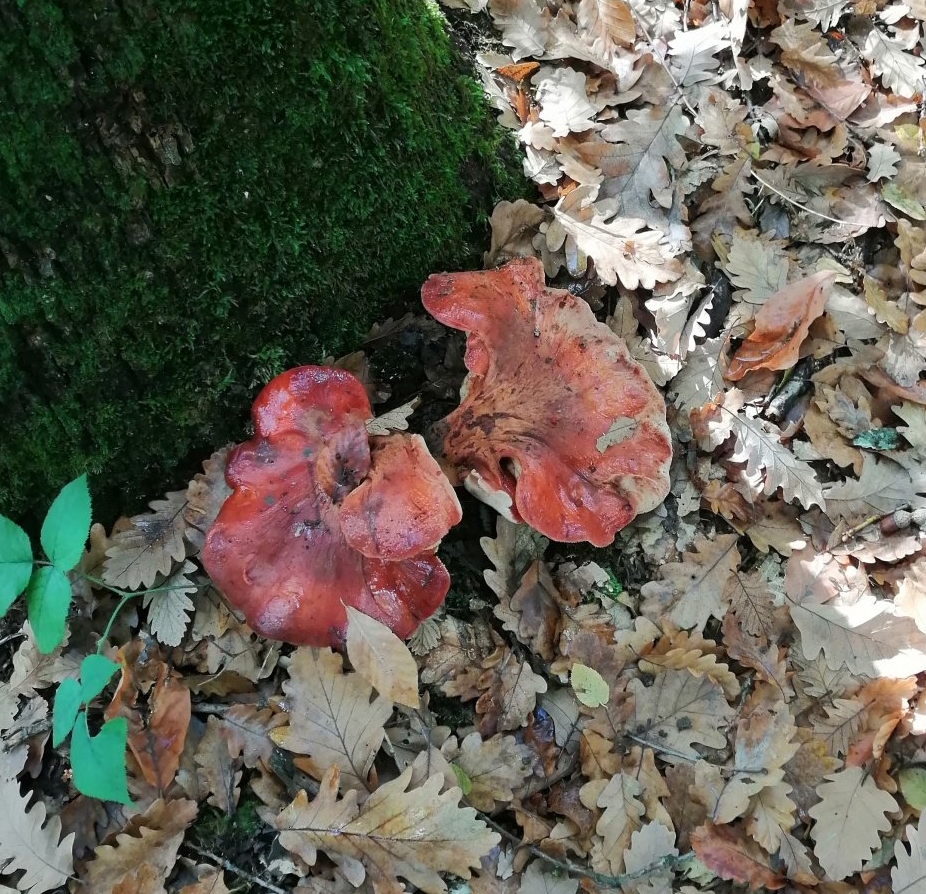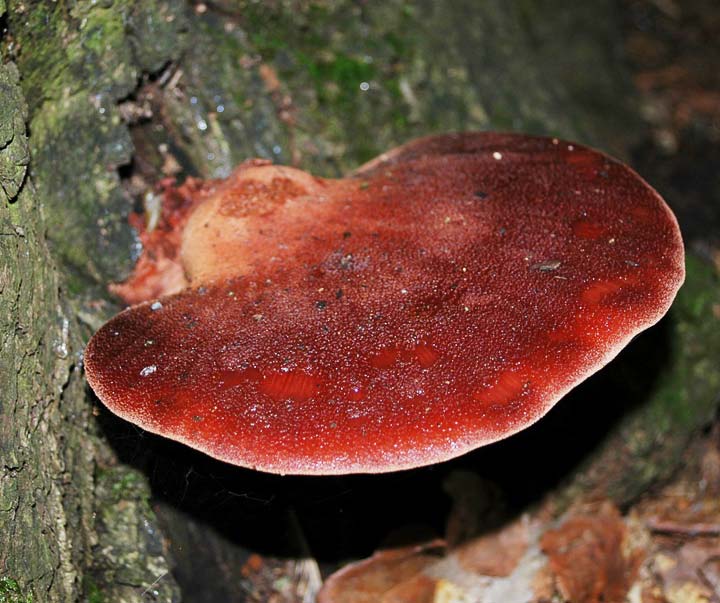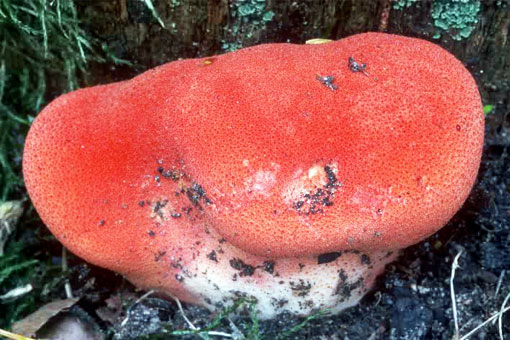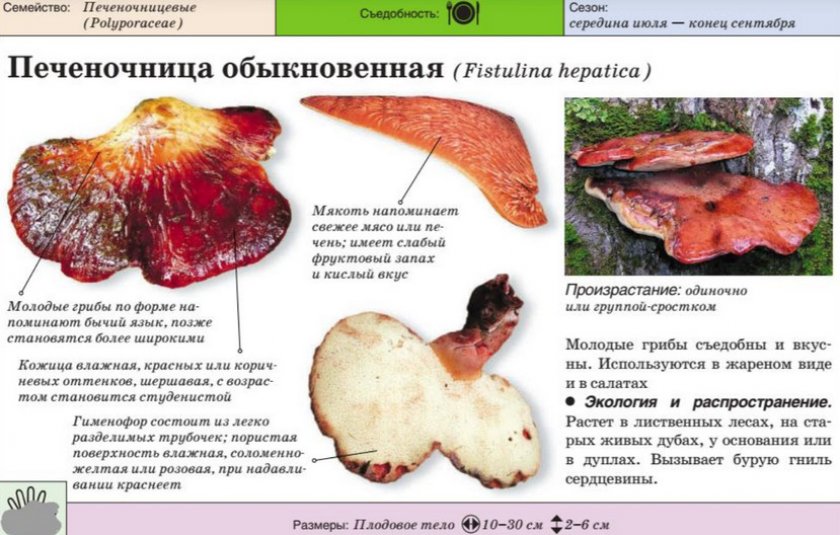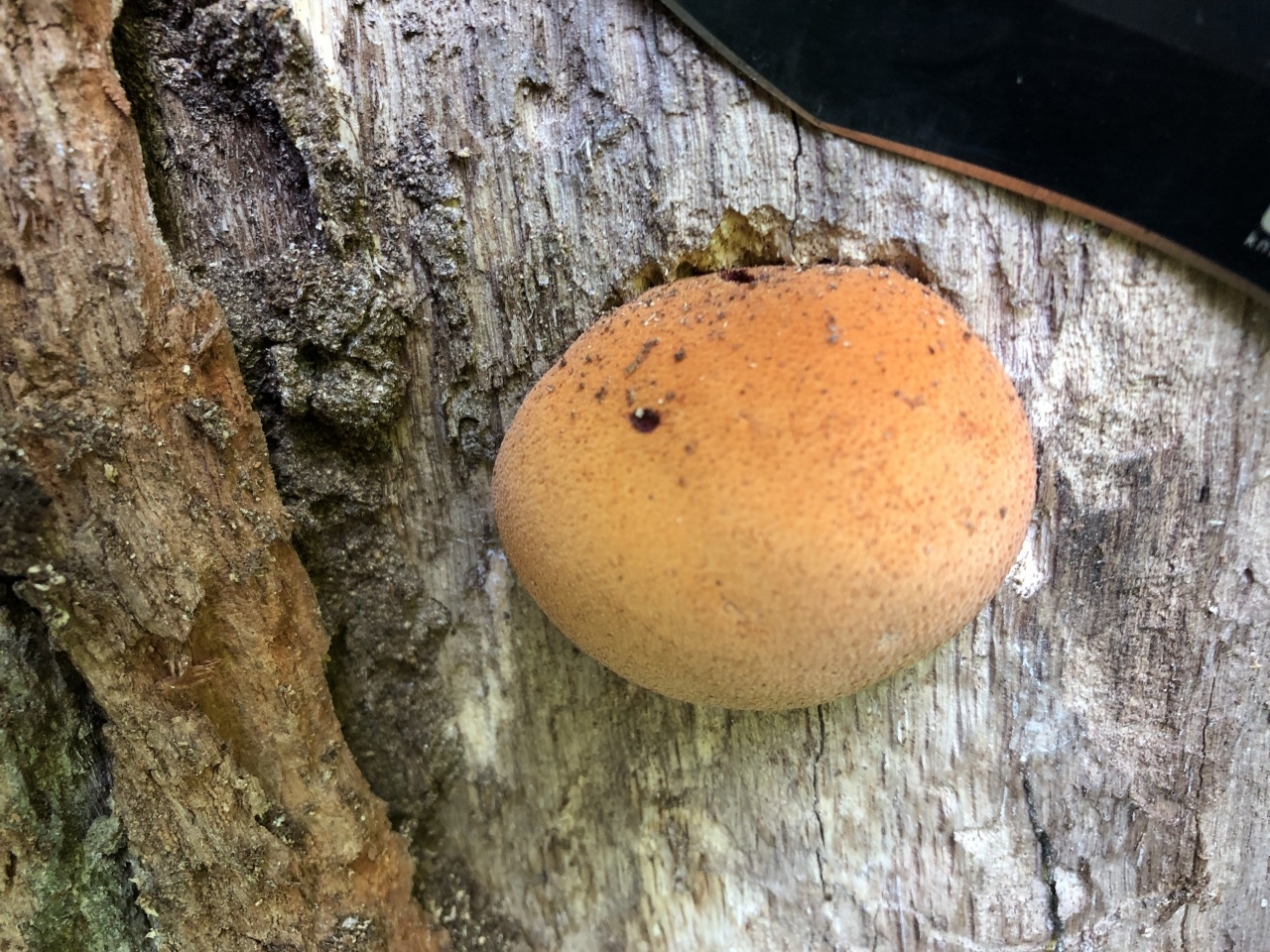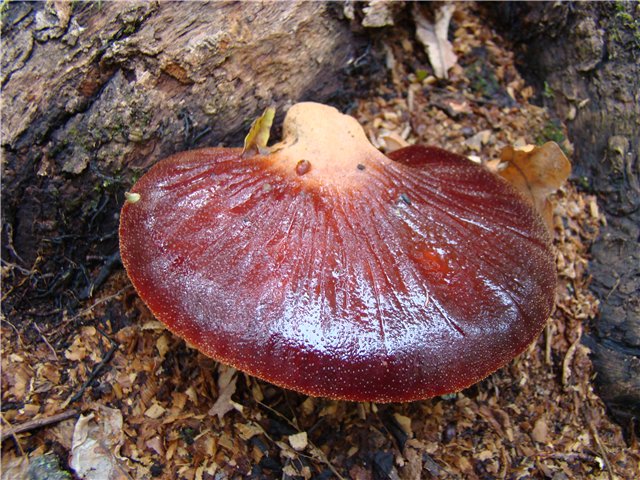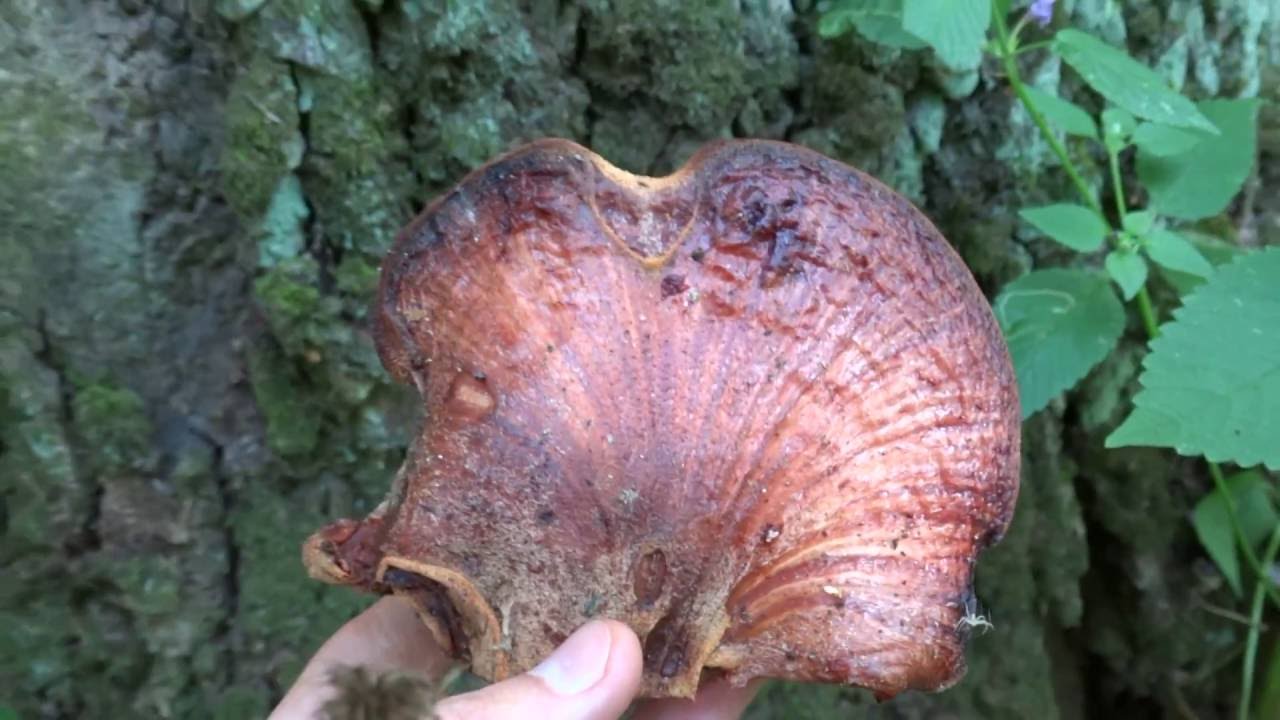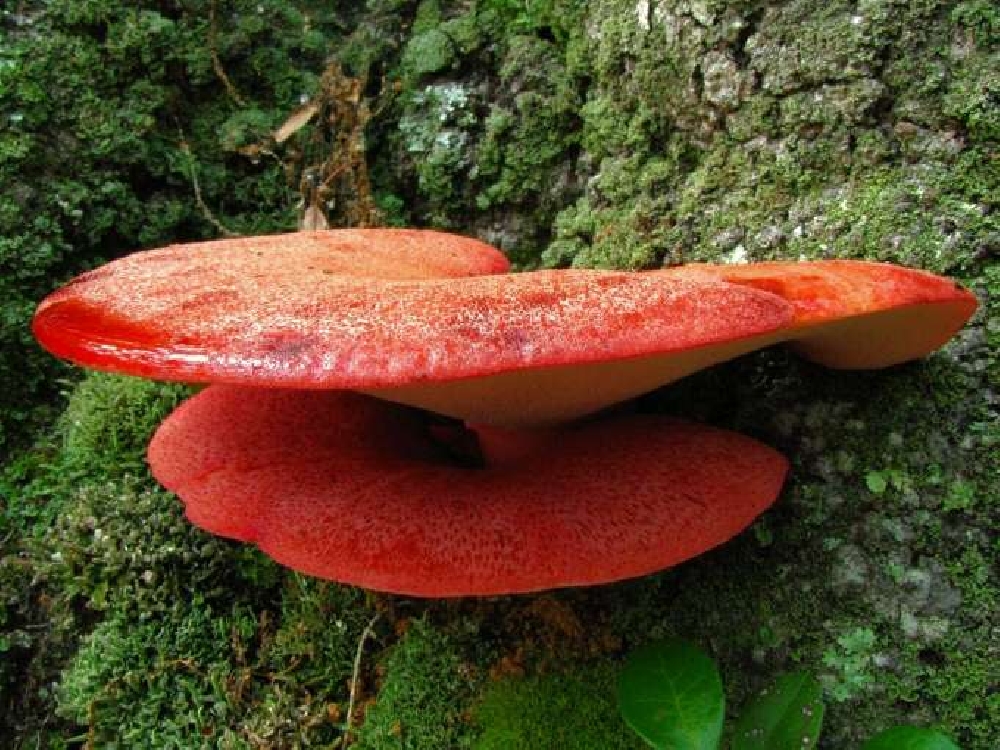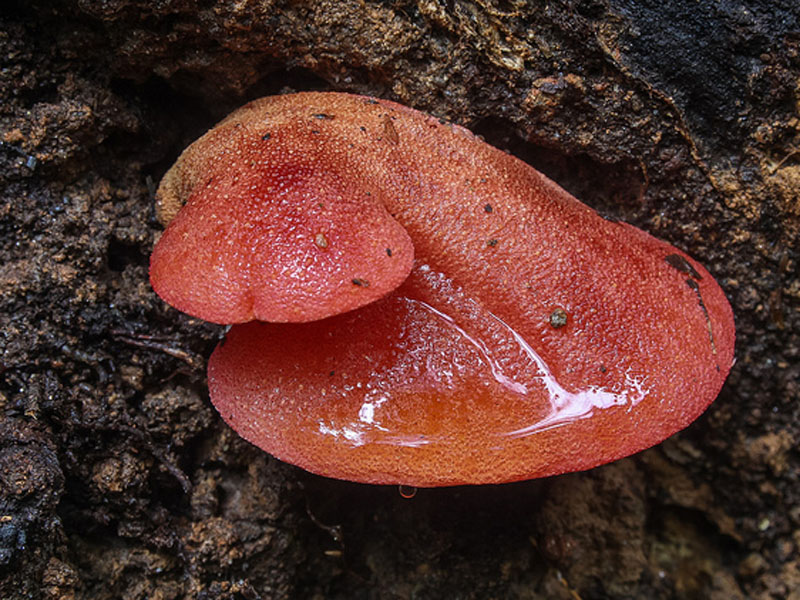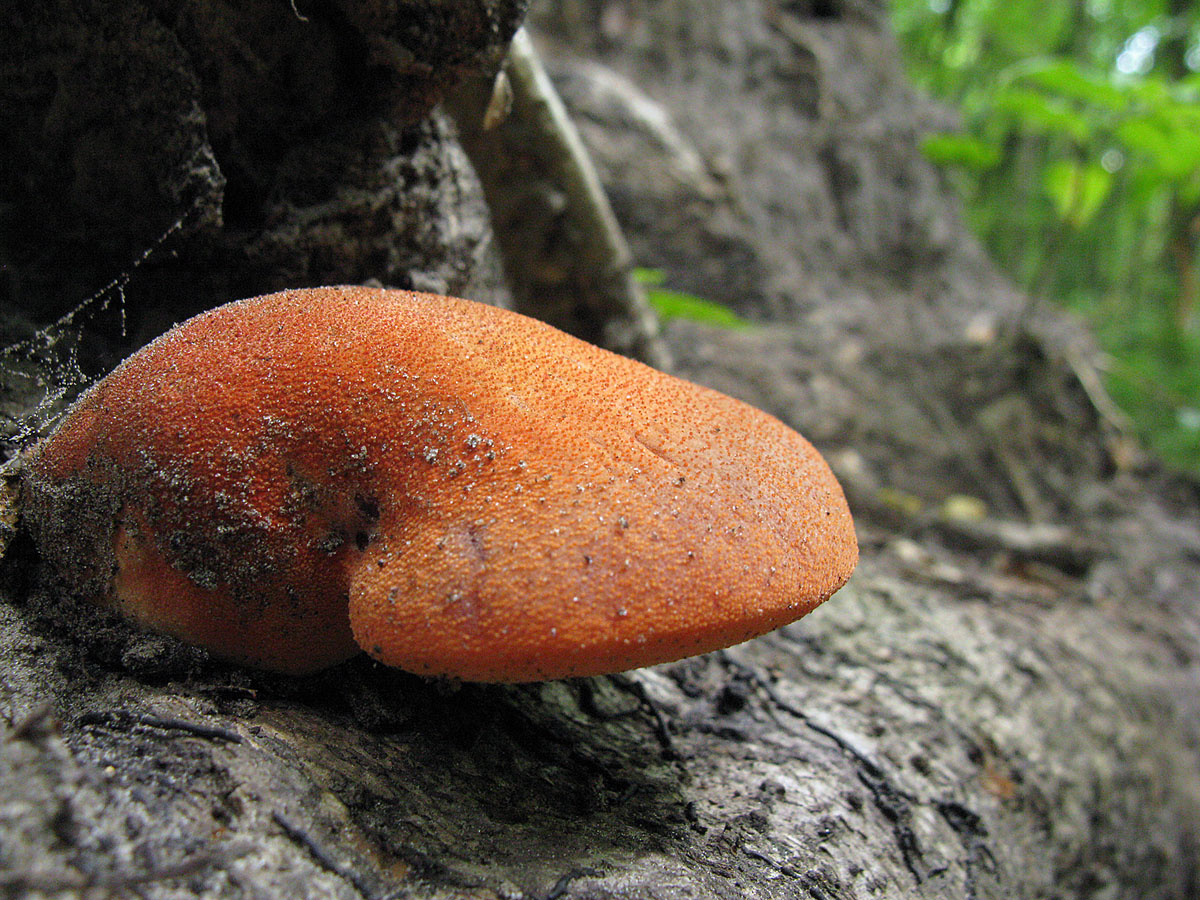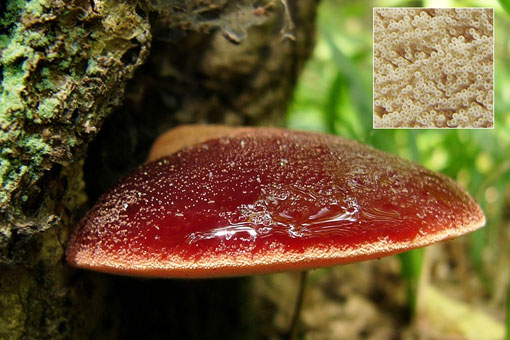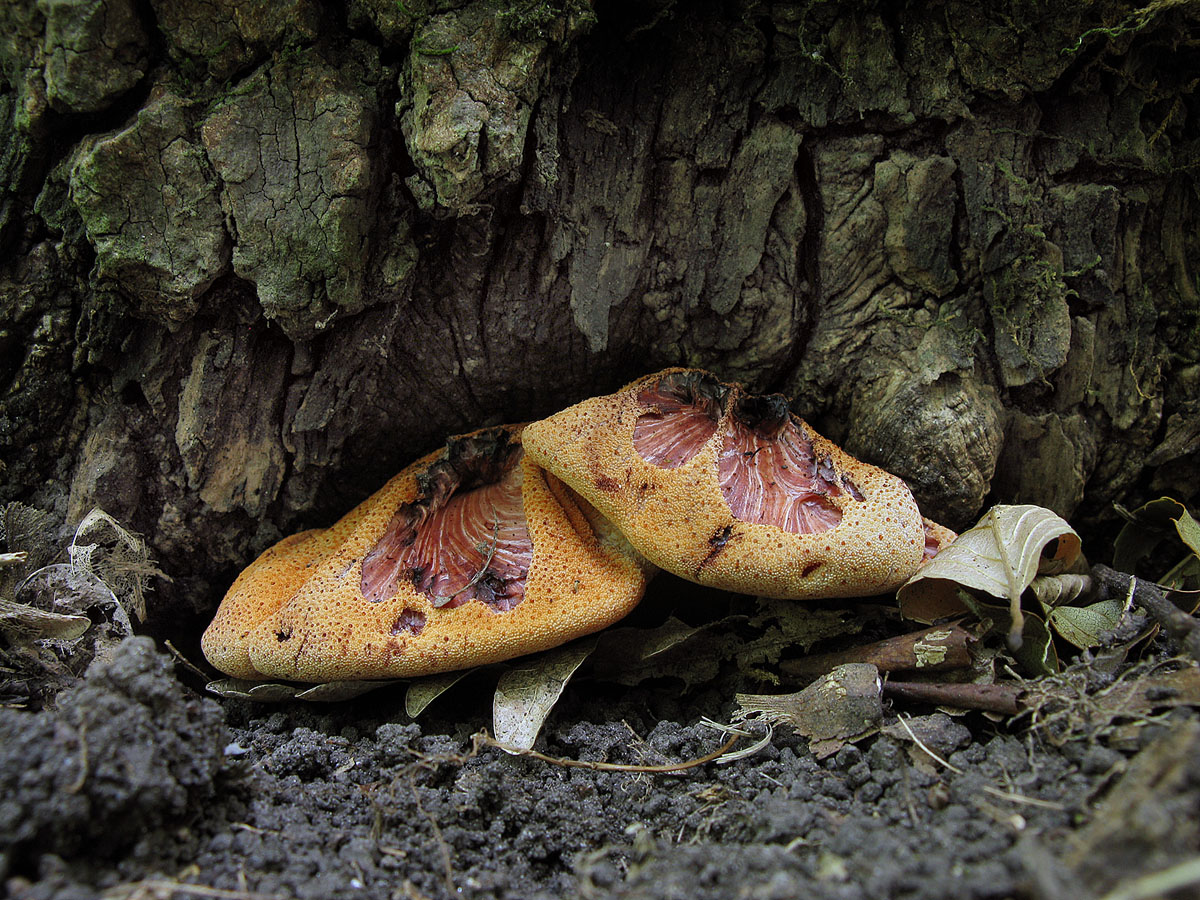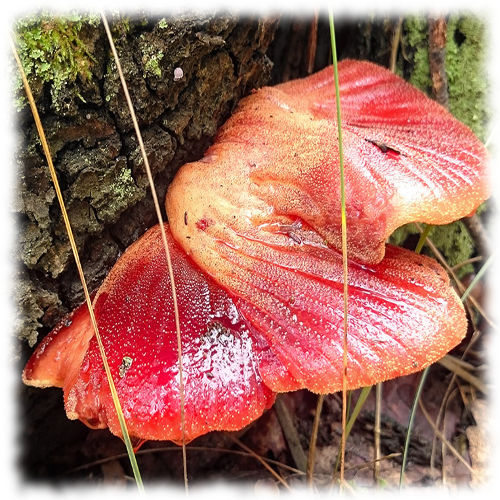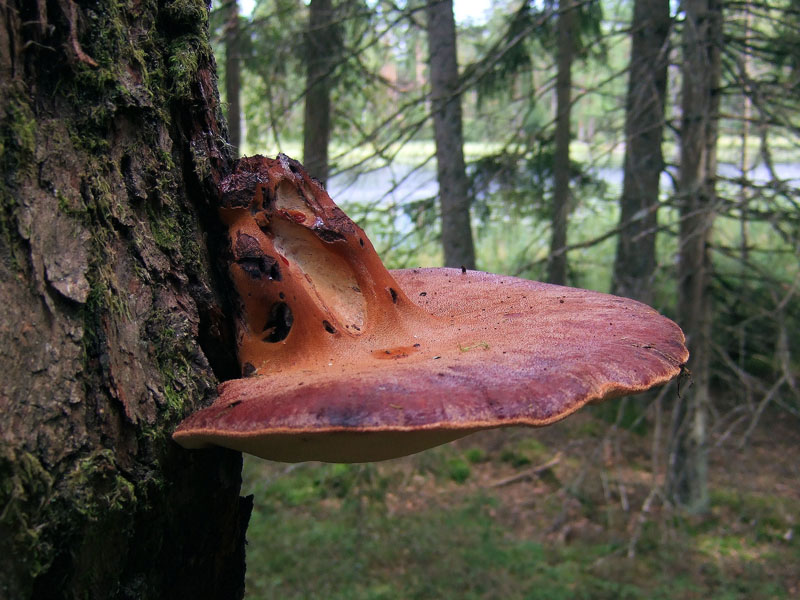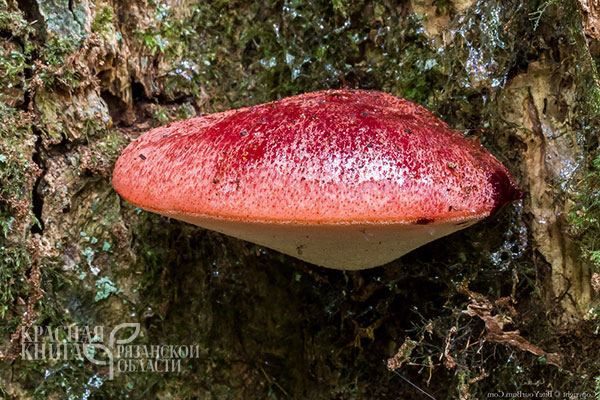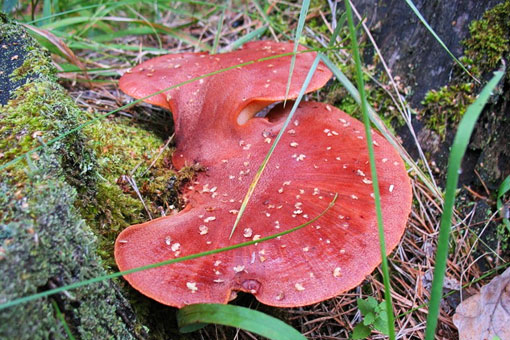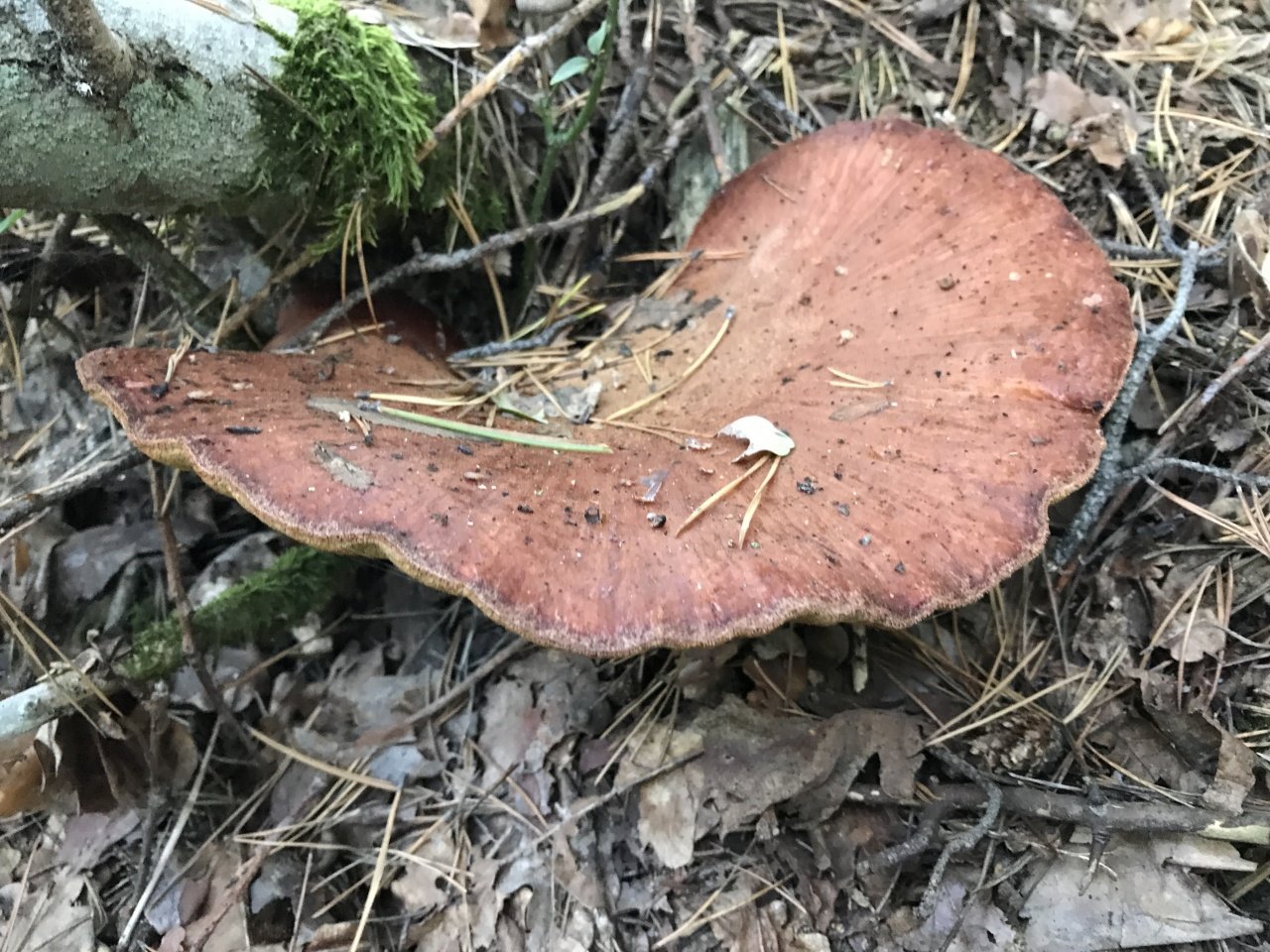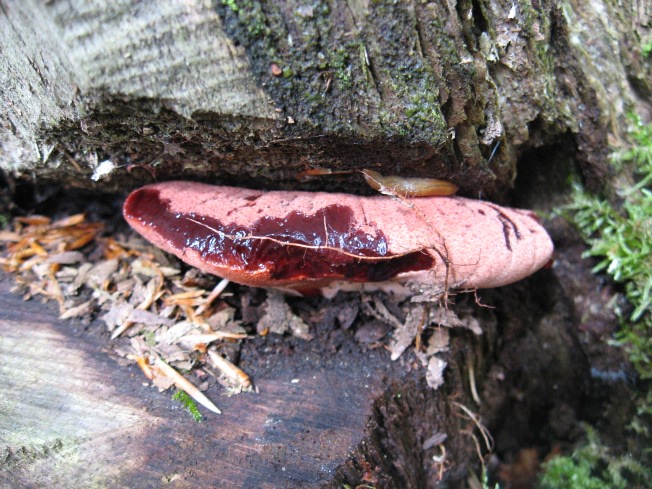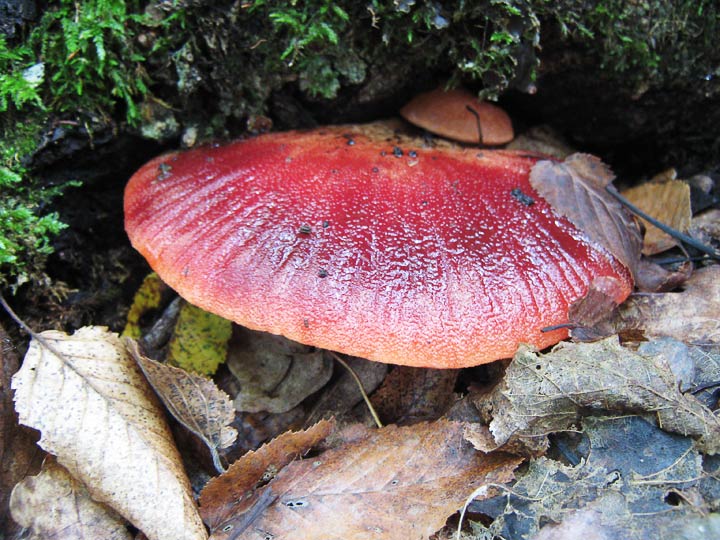Description of the liverwort.
The fruit body of this mushroom is large, its diameter reaches 30 centimeters. In young fruiting bodies, the form is rather shapeless, resembling a drip formation; in adulthood, the form becomes lingual, leaf-shaped or fan-shaped. The surface of the mushroom is shiny, smooth, sticky in wet weather.

The liverwort is attached to a tree with a short pseudopod. It is tough in structure. The color of the pseudopod is dark - at the top it is bright red, below it is dark red, and at the base it is cream or yellow.
The flesh of the liverwort is elastic. The color of the pulp is pink with red veins forming a marble pattern. When cut, this mushroom surprisingly resembles a piece of liver or meat, which is where the name comes from. The similarity is complemented by the secreted red juice. This juice is not very plentiful. The pulp tastes very sour.

The hymenophore in the mother-in-law's tongue is represented by separate tubules. The color of the tubes is beige or yellow, when touched, the tubes turn red. The color of the spore powder is pale brown or pinkish.
Useful properties of the common liverwort.
The liverwort mushroom is rich in vitamin C. 100 grams of the pulp of this mushroom contains the daily norm of ascorbic acid. In addition, liver mushrooms contain carbohydrates, proteins, minerals, vitamins D, PP, phosphorus and water.

There are special specialists dealing with fungal therapy, that is, treatment with mushrooms. These experts argue that mushrooms of the genus Tinder, of which the liverwort is a representative, have a beneficial effect in cancer. This fact has not yet received scientific confirmation. In addition, the liverworm contains the polysaccharide lanophil, which activates the liver's secretion of enzymes that restore metabolism.
Contraindications for taking liver mushrooms.
Hepatic mushrooms are not recommended for use in diseases of the stomach and intestines, gout, kidney and liver problems. Also, mushrooms are not recommended for children under 6 years of age.

Related species.
Bristly-haired polypore is an inedible, toxic relative of the common liverwort. Its fruiting body is capped. Most often, 2-3 caps grow together. The upper part of the cap is reddish-orange, and later turns dark brown or almost black. The surface of the cap is covered with fine hairs. The pulp is brown.
Bristly-haired polypores are common in the Northern Hemisphere. This species is a parasite that mainly affects broadleaf breeds. Most often, these mushrooms settle on apple, alder, oak, ash, walnut, elm, grapes, ficus, mulberry, poplar, pear, fir, beech.

Tinder fungus is also inedible. The fruit body is fan-shaped, sessile. The structure of the mushroom is cork. The edges of the fruiting body are thin. The pulp has a woody smell and a bitter taste.
Most often, tuberous tinder fungi grow in groups, but sometimes they are found singly. Fruiting of these mushrooms occurs throughout the year. Hilly polypores grow on stumps and fallen trees of deciduous species. Most often found on willows.
Common liverwort, or "mother-in-law's tongue": special properties and benefits
For me, the time from mid-summer to mid-autumn is the time for mushroom hunting. My grandfather always took me to the forest with him and taught me how to understand mushrooms. We collected various mushrooms, but my favorite was and remains a liver mushroom or “mother-in-law's tongue,” as my grandfather used to say. I always liked the way it looked, and my grandmother was amazingly able to cook it.
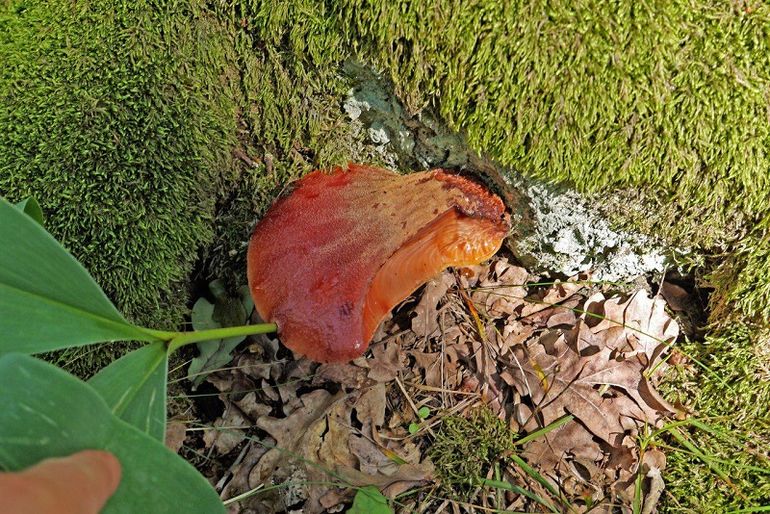
It turned out that this mushroom is also very useful. Therefore, the editors of "Caprice!" today he will tell you about the benefits of the liverwort mushroom and its beneficial properties, and personally I will tell you how my grandmother cooked this unusual mushroom.
Why mushrooms are useful
First, let's talk about the benefits of liver mushrooms. 100 grams of mushroom pulp contains the daily requirement of vitamin C. In addition, liver mushrooms contain carbohydrates, proteins, minerals, vitamins D, PP and phosphorus. This mushroom grows on a tree and absorbs all the most useful from it, thanks to which it becomes an excellent medicine. The ash of the mushroom is especially useful, it is used to treat many diseases.
To prepare the ash, the mushroom needs to be dried, burned and ground into powder. Take this ash for jaundice, arrhythmias, acute liver failure, atherosclerosis and for cleansing blood vessels, 0.5 teaspoon in the morning on an empty stomach and before bedtime for 20 days.
Remember that fungal treatment can only be an additional tool in the complex of therapy. Still, with serious illnesses, it is better to see a doctor.
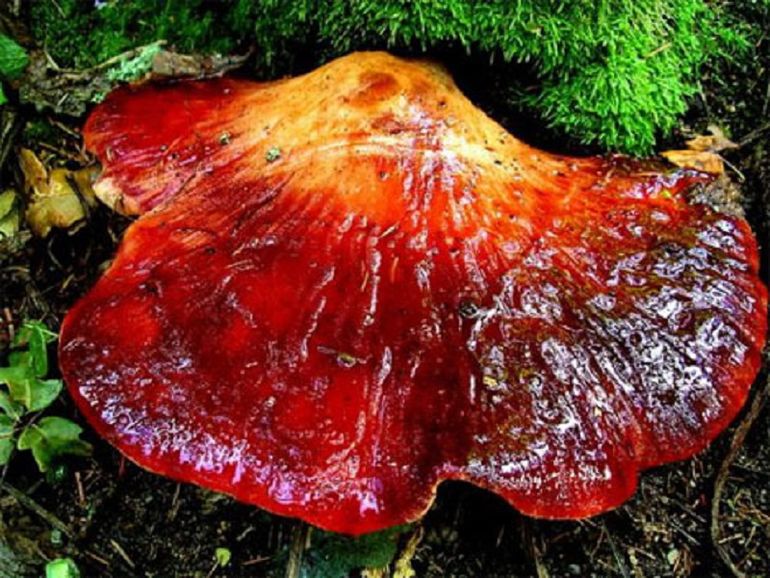
The mushroom is useful not only in the form of ash, but also prepared by the usual methods. But let's talk about cooking later, but for now let's find out what kind of mushroom it is and how to find it in the forest. So, the liverwort is ordinary - a representative of the Fistulin family, also known as the liver mushroom, liver tinder fungus and mother-in-law's tongue.
This is a fairly large mushroom, up to 30 centimeters in diameter. In young mushrooms, the body is rather shapeless, and in adulthood it resembles a tongue. The surface of the mushroom is shiny and smooth, sticky in wet weather. The mushroom is attached to the tree with a short pseudopod.

The flesh of the liverwort is elastic, the color is pink with red veins. On the cut, the mushroom resembles a piece of meat or liver, hence the name. The similarity is complemented by the red juice.
Liverwort can be found in forests from mid-July to late September. The mushroom grows preferably in warm areas, usually settles on live chestnuts and oaks. The mushroom is difficult to confuse with other species, because there are hardly that many mushrooms that look like liver.
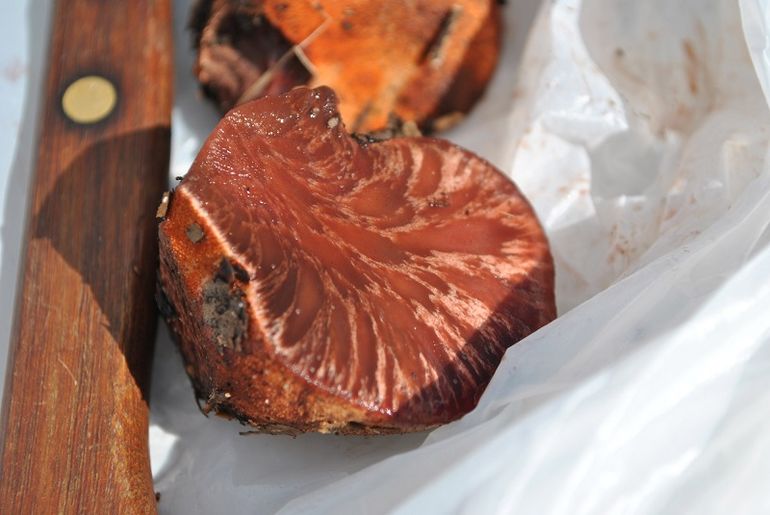
Mushrooms are edible, especially young fruiting bodies, the flesh of which is not yet stiff. These are delicate and tasty mushrooms with a certain sourness. They can be fried, baked, added to salads and pickled - it turns out delicious in any form. And now is the time to tell how my grandmother cooks this mushroom.
Preparation
Rinse the mushrooms well and remove the top skin from them. In general, it is recommended to soak them before cooking to get rid of the acidity, but you can just wash and boil well. Put the whole mushrooms in a saucepan, cover with cold water and put on fire. Cook for 20 minutes.

Peel the onion and cut into half rings or large cubes. Cut the slightly cooled mushrooms into pieces. Heat oil in a frying pan and add mushrooms there.

When all the moisture is gone from the mushrooms, add the onion and fry until tender. At the very end of frying, salt to taste. Here the mushrooms are ready, you can serve it on the table!
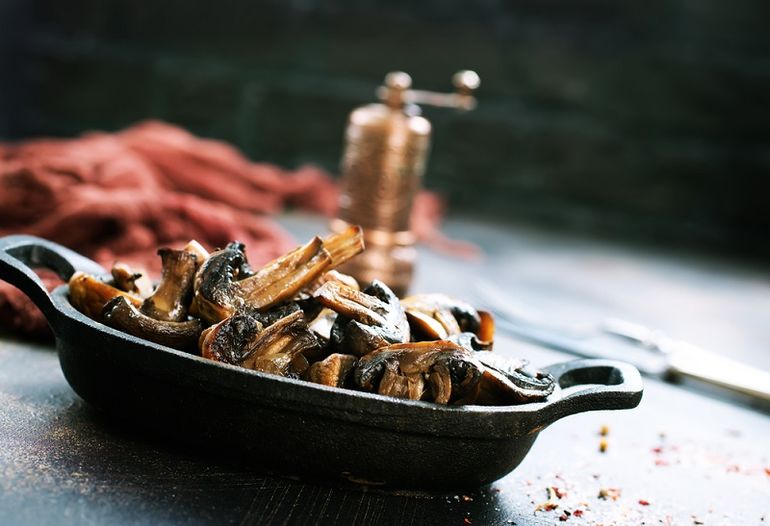
In this video you can see another way to cook deliciously "mother-in-law's tongue".
That's all we wanted to tell you about these beautiful and unusual mushrooms. Now you know where to find the liverwort and how to cook it. So you can safely go on a mushroom hunt!
And also, if you are a notorious mushroom picker, be sure to read our article on how to grow porcini mushrooms in your area. Maybe after that you don't even have to go mushrooming in the forest.
Growing at home and in the country
The liverwort can be grown in the country by introducing the mycelium inside an oak log (log, stump). The process consists of the following stages:
- In large logs and stumps, holes are drilled with a diameter of 10 mm and a length of 70 mm, the block is driven in completely. If the logs or hemp are small, holes of a smaller diameter are drilled, part of the bar is driven in there, and the part that remains outside is cut or broken off.
- If the wood is dry, before planting mycelium in it, you need to moisten it, “saturate it with moisture. Lumps are soaked for 2-3 days in containers with water or in natural reservoirs. A dry tree stump is poured 3-5 times a day for a week. The mushroom stick itself (oak bar) can also be kept in water for 1.5-2 hours before planting.
- After infection, the logs are placed in shady and humid places in personal plots or in rooms (basements, cellars, sheds). They can be left outside on an ongoing basis, the mycelium tolerates any frost, it is not necessary to cover it for the winter. Can be brought into a room with a positive temperature, where they will continue to bear fruit (from +8 ° C).
- The first mushrooms appear within 3–7 months after planting, in some cases up to 12 months, depending on the density of the wood and environmental conditions.
Liver (Fistulina hepatica)
Synonyms:
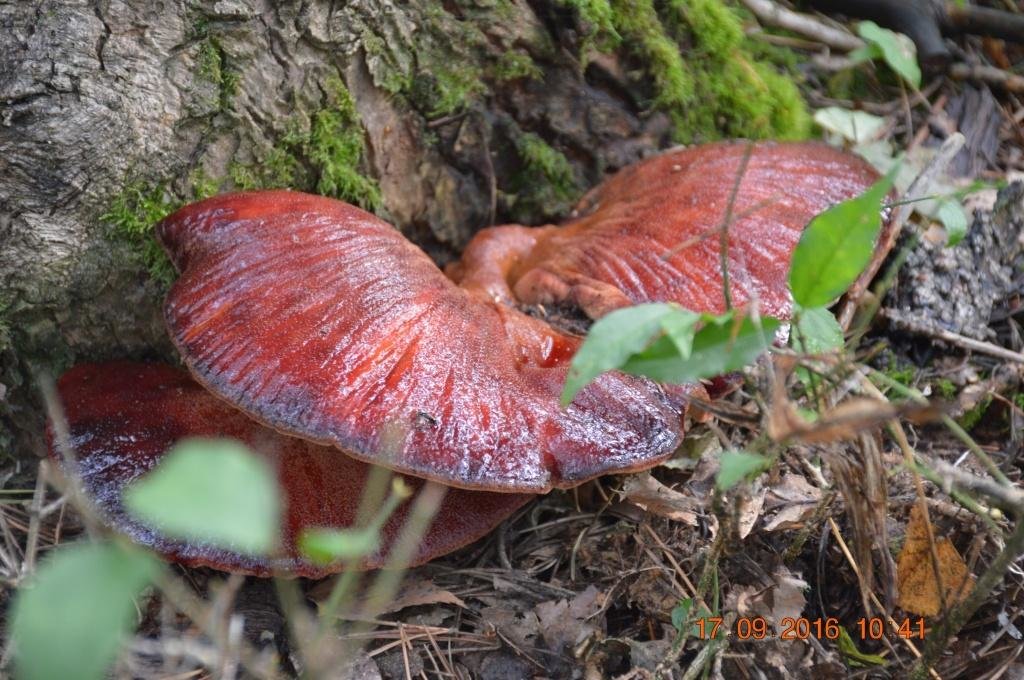
In English-speaking countries it is called "steak" or "ox tongue". In the Russian-speaking tradition, the name "mother-in-law's language" is often found. This mushroom looks like a piece of red meat stuck to a stump or base of a tree. And it really looks like a beef liver, especially when it begins to produce blood-red juice at the sites of damage.
Description
Hat: 7–20, according to some sources up to 30 cm in diameter. But this is not the limit, the author of this note came across copies and more than 35 cm in the widest part. Very fleshy, the thickness of the cap at the base is 5-7 cm. Irregular in shape, but often semicircular, fan-shaped or ligulate, with a lobed and wavy edge. The surface is wet and sticky in young mushrooms, dries up with age, slightly wrinkled, smooth, without lint. The color is liver-red, reddish-orange or brownish-red.

Spore-bearing layer: tubular. White to pale pinkish in color, then turns yellowish and eventually reddish brown in old age. At the slightest damage, with slight pressure, it very quickly acquires a reddish, red-brown, brown-meaty color. The tubules are clearly separated, up to 1.5 cm long, round in cross section.
Stem: lateral, poorly defined, often absent or in its infancy. It is colored from above in the color of the cap, and from below it is whitish and covered with a hymenophore (spore-bearing layer) descending to the leg. Strong, dense, thick.
Flesh: whitish, with reddish stripes, the cross section looks very beautiful, you can see an intricate pattern resembling marble on it. Thick, soft, watery. At the site of the incision and when pressed, it secretes a reddish juice.

Smell: slight mushroom or almost odorless. Taste: slightly sour, but not a must.
Spore powder: Pale pinkish, pinkish brown, rusty pink, pale brown. Microscopic features: spores 3-4 x 2-3 microns. Broadly almond-shaped or subellipsoid or sublacrimoidal. Smooth, flowing.
Hyaline to yellowish in KOH.
Ecology
It is saprophyte and is sometimes referred to as "weakly parasitic" on oak and other hardwoods (eg chestnut), causing brown rot.
Season and distribution
Fruit bodies are annual. The liverwort grows alone or in small groups at the base of trees and on stumps, from early summer to mid-autumn. Sometimes you can find a liverwort, growing as if from the ground, but if you dig out the base of the stem, there will certainly be a thick root. It is widespread on all continents where there are oak forests.
There are several varieties, such as Fistulina hepatica var. antarctica or Fistulina hepatica var. monstruosa, which have their own narrower regions of habitat and distinctive features, but they do not stand out as separate species.
Similar species
The liver mushroom is so unique in its appearance that it is simply impossible to confuse it with any other mushroom.
Edibility
The liverwort is edible. Too mature, overgrown mushrooms may have a slightly more sour taste.
One can argue about the taste of the liverwort, many do not like the texture of the pulp or sourness.
But this sour taste comes from the high vitamin C content of the pulp. 100 grams of fresh liverwort contains the daily requirement of this vitamin.
The mushroom can be cooked right in the forest, during a picnic, on the grill. Can be fried in a pan as a separate dish or with potatoes. Can be pickled.
Video about the mushroom Common liverwort:
The photographs from the questions in "Recognition" were used as illustrations for the article.
Tips for planting and caring for the liverwort outdoors
These are delicate plants: from year to year the bush grows, but rather slowly. As a rule, the more interesting the variety, the less it is in a hurry to multiply. It will not withstand the competition of powerful assertive plants; it must be protected from aggressors. But under favorable conditions, it produces self-seeding and naturalizes.


Only terry forms are not capable of producing seeds. Planting new liverwort bushes in this case depends on you - the plant will have to be propagated by division. You can divide them in early spring: before or even during flowering.
In the summer heat, it is better not to touch the plant. If you transplant it in the heat, it may not take root to die. Transplanting a flower in the summer is permissible only if you originally planted it in a very hot place and see that it dries up there. In this situation, you should find a shady place and try to transplant.
In the summer, it will be better to land the liverwort on a cool evening, and in this case, special care is needed. A fairly large hole should be dug so that the numerous roots feel free in the soil. You can add fertilizer right around the roots. After transplanting, water the plant, but do not flood it too much. Every two days during the week, you need to check how the flower has taken root, periodically water and fertilize it. If after a week the plant looks good, then it has taken root, and you no longer need to monitor it so carefully.
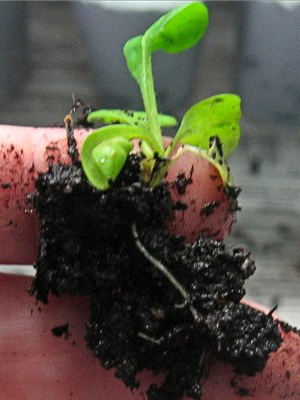

In order to better understand how to transplant this plant, look at the photo - it shows the planting of the liverwort and caring for it in detail and clearly.
You can fight the disease with the help of fungicides, but, as practice shows, the disease does not affect the development of the plant next year. It's just worth cutting off diseased leaves or parts of them in time, if you could notice the fungus at an early stage.


Planting a liverwort and caring for this plant in the open field is not very different from planting and caring for violets. The only thing worth considering is the acidity of the soil. Slightly acidic soil is suitable for liverworts. It is good to use compost and fallen leaves as mulch. Plants do not tolerate both drying out and flooding. If the leaves are well preserved in the summer, do not cut them off, they will overwinter and in the spring will give the plant the opportunity to receive nutrients.

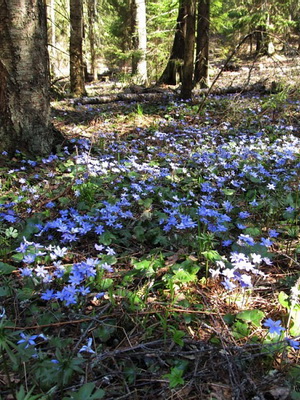
Liverworts grow in forests. In order for the cultivation of a forest liverwort in the garden to be successful, you need to try to bring the conditions closer to those natural for this plant. Therefore, a shady place should be chosen for them. Of course, with abundant watering, they will put up with the sun, but it is better to plant them among sedges, mountain goats and ferns.
Also daffodils, crocuses or primroses can be good neighbors for this flower. These are not very strong plants, so they will not "crush" a miniature lilac flower. Plus, together these flowers form a good composition, so they will look harmonious in your garden.
If you do not know which flower it is better to plant next to, look at the photo of the liverwort next to other plants:




-
Potted Flowers Plants for Paludarium 5 July
-
Potted flowers Plants suitable for the florarium 4 July
Literature
- Mushrooms: Handbook / Per. with ital. F. Dvin. - M.: "Astrel", "AST", 2001. - S. 240. - ISBN 5-17-009961-4.
- Grunert G. Mushrooms / per. with him. - M.: "Astrel", "AST", 2001. - S. 236. - (Guide to nature). - ISBN 5-17-006175-7.
- Lesso T. Mushrooms, determinant / per. from English L. V. Garibova, S. N. Lekomtseva. - M.: "Astrel", "AST", 2003. - S. 213. - ISBN 5-17-020333-0.
- Udu J. Mushrooms. Encyclopedia = Le grand livre des Champignons / per.with fr. - M.: "Astrel", "AST", 2003. - P. 67. - ISBN 5-271-05827-1.
- Harding P. Mushrooms / Translated from English. D.S.Schigel. - M.: "Astrel", "AST", 2002. - S. 197. - ISBN 5-17-011765-5.
Liverwort, Fistulina hepatica
Fruit body: Large, up to 30 cm in diameter, in youth, rather shapeless, similar to a drip formation, but with age it takes on a leaf-like, lingual or fan-shaped shape. The mushroom is attached to the surface of the tree using a short, dark and hard pseudopod. Above - bright red, then dark red and red-brown, below - yellowish, cream. The surface is smooth, shiny, sticky in wet weather. The pulp is thick, firm, pinkish, with red veins forming a “marble” pattern; on a cut, the liverwort is surprisingly similar to a piece of meat or liver; the similarity is complemented by the red sap, which, fortunately, is not very abundant. According to the literature, the pulp tastes very sour; persons who use the liverwort for food reject these data.
Hymenophore: Yellow or beige, with small, short, isolated tubes; when touched, it turns red.
Spore powder: Pinkish or pale brown.
Spreading: Liverwort occurs from mid-July to late September in warm areas, settling on live oaks or chestnuts, relatively infrequently. She is accused of the formation of brown rot of oak, but it is hardly justified - the liverwort rarely comes across, and it lives only on weakened, fairly hollow trees that have lost their bark.
Similar species: It is easy to say: “there is no other fungus in the forest that would look like a woody liver”. This is where the inhabitants of distant countries might object. In the southern hemisphere, the Antarctic liverwort, Fistulina antarctica, is found. The antipodes collect it and eat it.
Edibility: In young years, until the flesh is stiff, Fistulina hepatica is considered a good edible mushroom; what to do with acid, the authors do not explain to us.
Author's notes: It is difficult to say something original about a mushroom that grows in the forest like a strange liver. To be honest, before I met the liverwort in person, I believed that the name was, rather, a poetic exaggeration, the result of the projection of a living human feeling onto an impassive object of study. Also, I thought, the first astrologers saw distinct figures in the porridge of stars, the first mycologists poetically concluded that russula can be eaten raw, raincoats grow after rain, and the porcini mushroom has something to do with white. So I thought and was wrong. The liverwort is really an “external liver” that makes you remember the terrible karma of an alcoholic, whose liver continues to be pecked by straight and portable eagles even after everything else has become a meaningless tree, and about dryads suffering along with the hollow oak in which they found once a shelter, and about the unbearable reincarnation of an evil person who loved to torment the defenseless and therefore left with a bare liver outside, and much more, not directly related to mushrooms. It is interesting that the inhabitants of the southern regions look suspiciously at this romance: for them, our cognitive dissonance at the sight of a liverwort is like that before our very eyes someone will poetically admire a russula. Although, probably, I would have understood, or tried to understand.
This is less like a liver. Small but distinct pores are one of the hallmarks of the entire Fistulinaceae family. However, in our case, there is no special need to look at the pores - the liverwort cannot be confused with any other mushroom, even with an acute desire. But, on the contrary, you can move your finger over them - so we will see that reddish stripes appear on the injured place right before our eyes.
This one doesn't look so festive anymore. In their natural environment, older specimens of the liverwort are not so beautiful: you need to come closer, touch, pick with a knife in order to understand that this is not a simple mushroom.However, these burdocks of Fistulina hepatica seem small only against the background of a well-worn oak, they themselves are quite healthy.
And such a mushroom can be shocking. Red on pink streaks, "liver" consistency, red, blood-like drops of juice. No, we intellectually understand that this liver uses a pink acidic solution to neutralize the tannins that protect the oak itself, but the impression is still very physiological. At least at the first meeting with Fistulina hepatica.
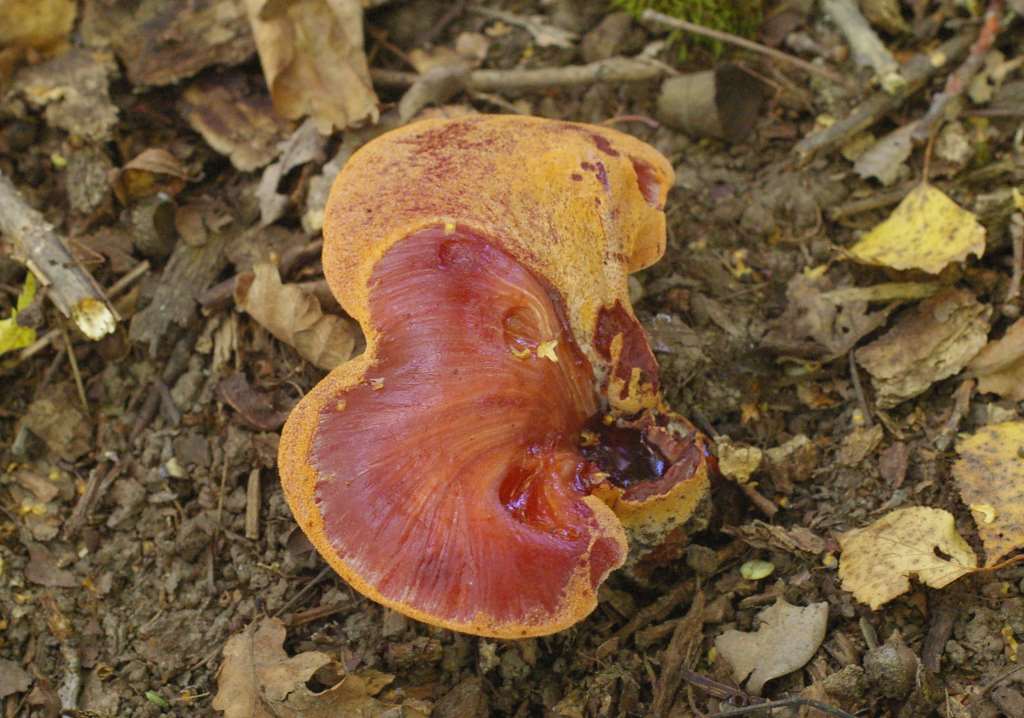
And this liverwort has already been eaten by someone. The mushroom grew directly on the soil (more precisely, on oak dust), and one of the inhabitants of the forest has already taken a craving for it, although the matter is clearly not brought to the end. Maybe the truth is sour.
Common decorative types of liverwort
The genus is not numerous, includes, according to different classifications, from 2 to 10 species. In Russia, only the noble liverwort, or the common liverwort (H. Nobilis), grows in nature. This species with tripartite dense leaves on long petioles and single lilac flowers up to 4 cm in diameter feels good both in shady places and in illuminated areas on loose, moderately moist soil. In culture, there are terry varieties of white, purple, pink, purple color. There are subspecies:
To date, about 1000 varieties are known. Due to the difficulties with reproduction, prices for new items reach $ 3,000. Flowers are especially popular in Japan, where exhibitions of flowering liverworts are held annually, varieties have been created not only with double flowers of various colors, including two-color and tricolor, but also with variegated foliage.
Photos of liverworts of various types and varieties are shown below.
4. Reproduction
The liverwort reproduces in only two ways - by dividing large adult plants and growing from seeds.

4.1 division of plants
Every 5 years, the liverwort bushes are dug up and divided into several parts - this is the most common method of flower reproduction. For this, the rhizome is freed from the soil, the location of the renewal buds is determined. Cut the rhizomes into pieces with a sharp garden knife or pre-sterilized secateurs. The division is carried out in such a way that 2 - 3 kidneys remain in each part.
The wounds formed as a result of division are sprinkled with wood ash or crushed activated carbon powder. Such delenki are planted in different places and at first they are watered carefully, keeping the soil moist, but not swampy.
If, as a result of division, too small specimens are obtained, then they should be kept in a greenhouse with high air humidity and a sufficiently high temperature. In the first month after dividing into young bushes, the direct rays of the sun should not fall.

4.2 Growing from seeds
Not all plant varieties can be obtained from seeds - for example, in the Asian liverwort and terry varieties, even when pollinated, they are not formed - it reproduces by segments of rhizomes. Other liverworms, for example Transylvanian, willingly give seeds, often self-seeding can be found under adult plants.

For the reproduction of species liverworts, you can use your own collected seeds - for this, the seed pods are allowed to fully ripen right on the plant. Full maturation occurs within 1 - 1.5 months after flowering. The collection is carried out in good - dry and warm weather, usually in late June - early July. In order to prevent the seeds from spilling onto the ground on their own, you can pre-dress the seed pods with gauze protection.
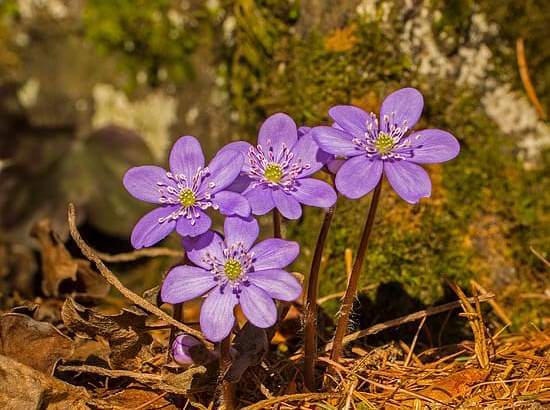
The seed pods are cut, opened and the seeds are poured out. Each multi-root fruit can contain from 20 to 60 seeds. Interestingly, in the natural habitat, the spread of the liverwort is facilitated by ordinary forest ants - they take away ripe seeds that have scattered over the surface of the soil.Since the planting material quickly loses its germination over time, it is advisable to use it immediately after collection.

Certain agricultural techniques are used for seed propagation. For sowing, small grooves are prepared in an area in partial shade. Seeds are sown and covered with a small layer of soil on top. After sowing, the area is watered with water until it is completely saturated. The first sprouts of the strongest specimens can be observed after a couple of three weeks, and some seeds will sprout only next year - in the spring.
In the first days of spring, small cotyledonous leaves can be seen in places where seeds are sown. A year later, next spring, the plants form the first true leaf blades.
For seed reproduction, a florist should be patient, because under the most favorable conditions, the first buds will decorate plants grown from seeds only for 3-4 years of life.
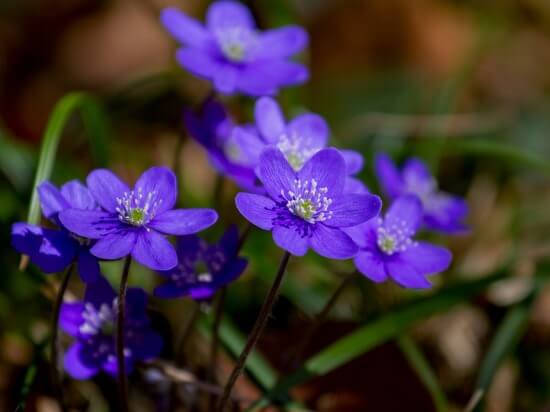
7.Application in landscape design
A perennial liverwort can decorate almost any area. With its early flowering and bright buds, it will delight the eye at a time when most plants have not yet acquired foliage. A flower is often planted in the near-trunk circles of large-sized trees - shrubs and trees, since only shade-tolerant plants can be planted in such places. The liverwort will also decorate an alpine slide, but it should be placed at the foot - where there is more shade and moisture, in addition, the flower prefers to settle on rather steep slopes.
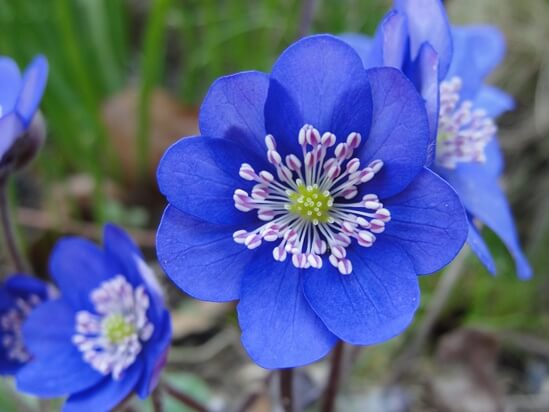
The flower looks great next to other primroses - snowdrops, crocuses, white flowers and chionodox. Group planting of plants is also effective. Many varieties of the flower have not only beautiful buds, but also attractive leaves - green with white spots, which will decorate the garden after the plants have faded. So the liverwort can be used not only as a flowering perennial, but also as a decorative leafy plant.
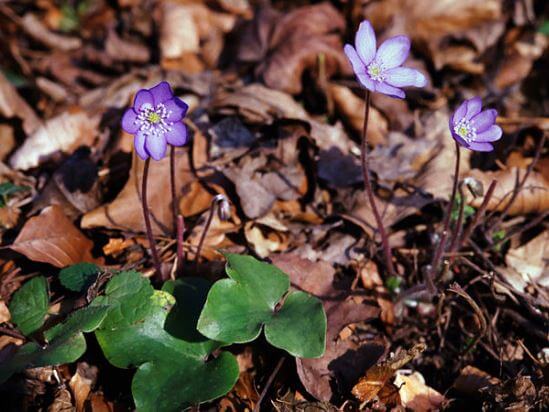
How to propagate
Liverwort noble feels great in a garden and reproduces by self-seeding. The Transylvanian liverwort also reproduces without too many problems. There may be problems with other varieties, but they can be solved.
- Division of the curtain. Using this method, you can get an impressive amount of planting material. Plants are divided when they reach 4-5 years of age, during this period they already have an impressive root system. The liverwort bush is dug up, shaken off and divided into small divisions. Then they are planted in fertile soil and mulched.
- Reproduction by seeds. The flowers of an unpretentious primrose can be obtained by seed propagation. If the seeds set and begin to ripen, you must carefully monitor them. Once the seed has brightened, it is placed in a small bag of vermiculite. Keep it in a cool place before sowing. Germination occurs after winter stratification.
- Liverwort and other varieties can multiply by rooting a rosette. For this, a cut is made from the bottom of the socket, treated with "Kornevin" and planted in a container. Of course, there are not very many chances that the plant will take root, but, as practice shows, after a while, the rosettes most often take root.

Description of the mushroom
This species received its unusual name for its resemblance to the liver of animals, it is called the Common Liver, Common Liver, Liver Tinder. The people humorously call Mother-in-law or wolf tongue. In Europe and among the Western Slavs, the species is called the Bolovy language. The English popular name - The poor man's beefsteak - is quite eloquent.
The Latin name is Fistulina hepatica. Type: Basidiomycota, Order: Agaricales, Family: Fistulinaceae.
Liver mushroom has recently been included in the Red Book of Belarus, protected by law in Poland. The cost of 1 kg of mushroom in Europe varies from 6 to 50 euros.
The cap has a lingual, elongated shape, tapering towards the stem.Its size varies from 25 to 30 cm, thickness is about 6 cm. The surface is sticky, lumpy. In young specimens, it has an orange color, slightly rough, with age it becomes purple-burgundy, gelatinous.
The hymenophore (lower part of the cap) is finely porous, first yellowish, then brown. On examination, it seems that this layer consists of small tubes. When pressed, it darkens, often the surface begins to become covered with pink drops, which led to the name of the species.
The pulp is characterized by a dense, elastic structure, it is fleshy and juicy. In adult specimens, it hardens, becomes fibrous. The smell is slightly fruity, the taste is sour-bitter.
The leg is lateral, short, often not visible at all.
Liver or hepatica (Hepatica) ordinary and noble
Liverwort, coppice or hepatica (Hepatica) is a genus of perennial grasses of the buttercup family that grows in the forests of the temperate zone of the Northern Hemisphere. Used in decorative floriculture.
- Family: buttercup.
- Homeland: Northern Hemisphere.
- Rhizome: short, tuberous.
- Stem: straight.
- Leaves: petiolate, three-lobed.
- Fruit: nut.
- Reproductive ability: propagated by dividing rhizomes, seeds.
- Illumination: shade-tolerant.
- Watering: moderate.
- Content temperature: frost-resistant.
- Flowering duration: 3-4 weeks in April-May.
Description of the liverwort flower
An early flowering perennial plant 15-20 cm high with a rosette of three-lobed, petiolate, pubescent leaves at the beginning of the growing season, red-violet, then dark green, dense, leathery, in some species wintering. The flower of the liverwort, or hepatics is blue, less often white or pink, single, 2-4 cm in size, located on a straight pubescent naked peduncle, has the form of a calyx with 6-10 petals. All parts of the plant are poisonous.
Common decorative types of liverwort
The genus is not numerous, includes, according to different classifications, from 2 to 10 species. In Russia, only the noble liverwort, or the common liverwort (H. Nobilis), grows in nature.
This species with tripartite dense leaves on long petioles and single lilac flowers up to 4 cm in diameter feels good both in shady places and in illuminated areas on loose, moderately moist soil.
In culture, there are terry varieties of white, purple, pink, purple color. There are subspecies:
Asiatic liverwort (H. asiatica), sometimes isolated as a separate species, grows in the Far East, China, Korea, Japan, has white, pink, purple flowers, unlike the noble liverwort, sheds its leaves for the winter;
Japanese liverworts (H. japonica) and pubescent (H. pubescens), the latter is distinguished by rounded leaves with a marble pattern.
Liverworts sharp-lobed (H. acutiloba) and blunt (H. acutiloba, H. americana), native to America.
Its one European species, H. transsilvanica, a native of the Carpathians, is distinguished by its large blue or purple flowers and deeply cut trifoliate leaves.
In a separate species called the middle liverwort (H. media), a group of hybrids of the Transylvanian liverwort with other species is distinguished. These are plants with double flowers of blue, white, pink colors, blooming in April for a longer period than other garden forms.
To date, about 1000 varieties are known. Due to the difficulties with reproduction, prices for new items reach $ 3,000. Flowers are especially popular in Japan, where exhibitions of flowering liverworts are held annually, varieties have been created not only with double flowers of various colors, including two-color and tricolor, but also with variegated foliage.
Photos of liverworts of various types and varieties are shown below.
Cultivation and reproduction of the liverwort
The liverwort is a durable plant, its life expectancy can reach 25 years.
Natural forms require specific conditions, more humid and fertile soil with the addition of peat and spruce needles, transplantation and division every 3-4 years.
Garden varieties are less whimsical, develop well in the shade and in the open sun, in dry and moderately moist areas, can grow without dividing in one place for a long time.
All liverworts prefer light, well-fertilized soils with a neutral or slightly acidic reaction, and a semi-shady location. They can grow in significant shade and on alpine hills, near large stones, but in the sun the flowering time is reduced.
Liverwort flower in the photo.
The plant is poorly competitive; in order to obtain spectacular flowering clumps, it must be protected from intensively growing neighbors.
The rest of the care is not difficult, it consists in maintaining the soil in a moderately moist and weed-free state.
Propagated by dividing rhizomes or seeds. Reproduction by seeds is difficult, they often fall off unripe in early June, and in terry forms they do not tie at all. Sowing is carried out in June in a non-seedling way into the ground with freshly harvested seeds. Seedlings will appear in a year, seedlings will bloom in 3-4 years.
Varieties, hybrids, sterile, including terry forms in July-August are divided into parts, leaving at least 2-3 buds on each. They are seated at a distance of 20 cm, watered and shaded. By the fall, the delenki take root and usually bloom the next year.
Useful properties of the liverwort
The liverwort has many medicinal properties, thanks to which it is popular in folk medicine:
- stimulates the secretion of bile, thereby stabilizing the work of the gallbladder;
-
effective for various liver diseases;
- able to increase diuresis;
- has an antiseptic effect;
- possesses anti-inflammatory, expectorant properties, therefore, no worse than infusions of perilla, copes with colds, coughs, bronchitis;
-
relieves pain in polyarthritis and rheumatism;
- effectively eliminates boils, rashes, stops the decay of infected wounds;
- anti-inflammatory effect helps in the fight against streptococcus and staphylococcus;
- the presence of anemonin helps to suppress the spread of tubercle bacillus;
- cleans the blood.



